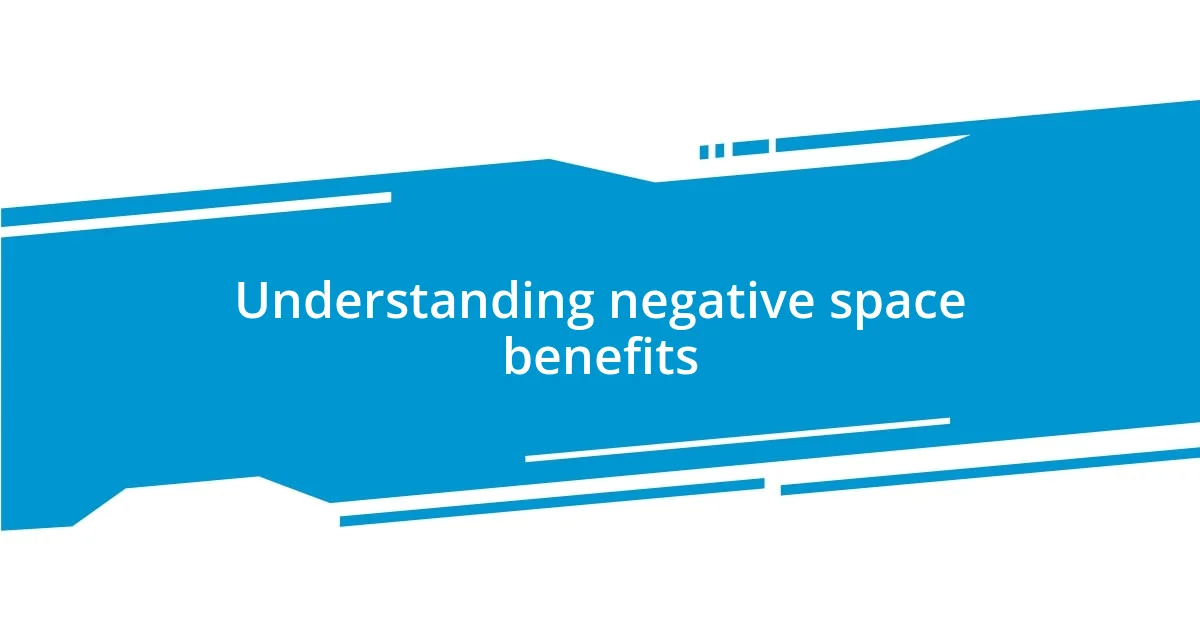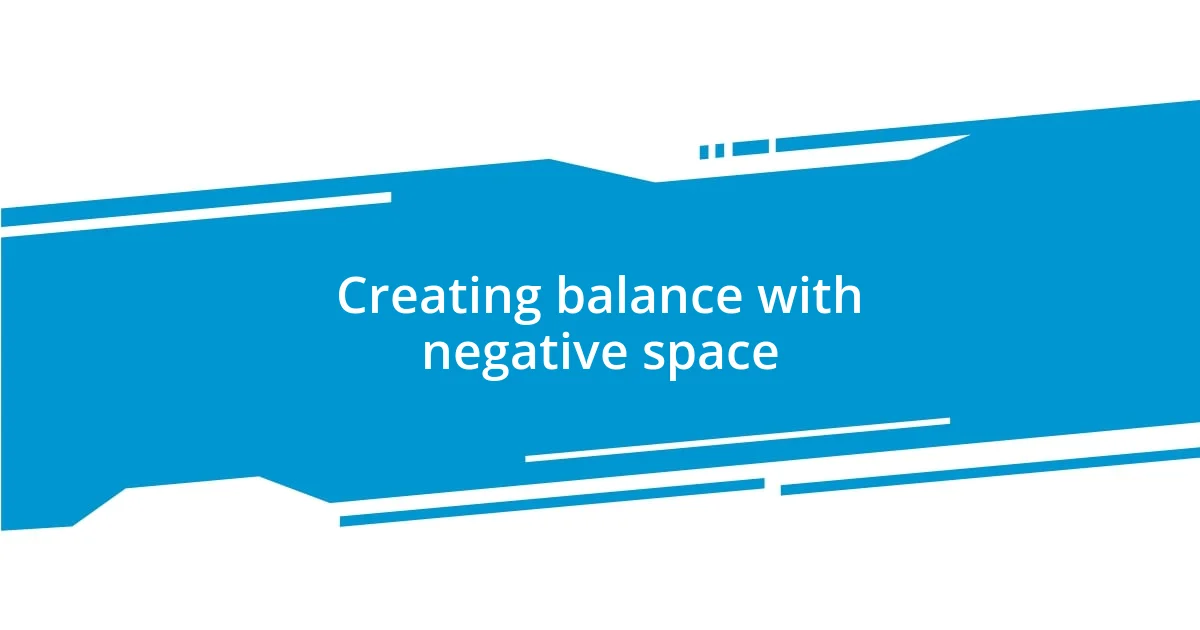Key takeaways:
- Negative space is a powerful design tool that enhances focus, balance, and emotional connection, allowing viewers to engage deeply with content.
- Effective composition techniques, such as layering elements and using the rule of thirds, maximize the impact of negative space and create harmony in design.
- Practical exercises, including silhouette challenges and analyzing successful designs, help develop a mastery of negative space and its role in storytelling.

Understanding negative space benefits
When I first started exploring design, I overlooked negative space, thinking it was just empty space without purpose. However, I quickly realized that it acts as a powerful tool to enhance focus and clarity. Imagine standing in a room filled with art—where do your eyes land? Often, it’s on the piece that has room to breathe, illustrating how negative space can draw our attention where it matters most.
I remember redesigning my portfolio and opting for a minimalist approach, which included generous negative space around each project. Not only did this decision highlight my work, but it also created a sense of calm for viewers. It made me ponder: isn’t it fascinating how what we don’t fill can sometimes speak louder than what we do?
Negative space creates balance, acting like a visual pause that allows ideas to resonate. Each time I share my work with others, I notice how they seem to take a deep breath as they absorb the simplicity. This emotional reaction reinforces my belief that effective use of negative space invites reflection and connection, making the viewer experience more engaging and thoughtful.

Identifying negative space elements
Identifying negative space elements is a crucial step in mastering design. When I start a project, I usually take a moment to observe the layout and recognize areas where the space between elements can create a dialogue. For instance, in a recent branding project, I noted how a large expanse of white around the logo not only provided clarity but also emphasized the brand’s essence, allowing it to stand out without overwhelming the viewer.
As I continue to refine my design skills, I’ve found that some of the most effective uses of negative space come from simple observations. During a visit to a gallery, I was mesmerized by a sculpture that was surrounded by bare walls. This deliberate approach allowed the piece to command the space, making it feel like a conversation with the viewer. I realized that negative space isn’t just the absence of elements; it breathes life into the composition, encouraging us to engage with it on a deeper level.
Reflecting on my experiences, I’ve come to understand that recognizing where negative space exists often leads to unexpected creativity. In my own work, I embraced the challenge of balancing text and imagery on a poster, specifically leaving a chunk of the background untouched. This decision invited questions about what was unsaid, creating intrigue. I ask myself: how might we redefine our perception of space to enhance not only our designs but also our thought processes? The possibilities are endless.
| Negative Space Elements | Description |
|---|---|
| Whitespace | Open areas that define the relationship between elements. |
| Margins | Spaces around content that offer breathing room. |
| Alignment | The positioning of elements that creates visual flow. |
| Proximity | How close elements are to one another, influencing the viewer’s understanding. |

Techniques for effective composition
While composing a visual piece, I’ve found that layering elements thoughtfully can significantly enhance the effectiveness of negative space. For instance, I once created a poster for an art exhibition that featured a central image surrounded by spacious margins. The image didn’t feel crowded; instead, it exuded confidence. This subtle balance caught my audience’s attention effortlessly, proving how strategic placement allows the message to shine without distraction.
One technique I often use is the rule of thirds. By dividing the space into nine equal segments, I can place focal points at intersections to create intrigue. When I applied this to a website design, I positioned the call-to-action button off-center, surrounded by ample white space, which naturally guided users’ eyes right to it. Combining these techniques not only emphasizes key elements but also fosters a harmonious composition that feels intuitively balanced.
Here are some techniques I implement for effective composition:
- Layering Elements: Arrange components thoughtfully to create a hierarchy in visual importance.
- Rule of Thirds: Use this guideline to place focal points at junctions for a more engaging viewer experience.
- Consistent Margin Size: Maintain uniform margins for a cohesive look, enhancing flow throughout the piece.
- Intentional Proximity: Position elements to convey relationships and evoke emotion, fostering a narrative within the design.
- Contrast: Utilize contrasting elements—like bold colors against white spaces—to amplify visual impact and draw attention.
By focusing on these techniques, I continuously evolve my understanding of how negative space can transform a composition from ordinary to extraordinary.

Creating balance with negative space
When I think about balance in design, I immediately recall a minimalist project I worked on for a local café. The layout featured just a few carefully selected elements, including their logo and a small menu item list, all surrounded by a generous amount of white space. This approach didn’t just create a serene atmosphere; it made each element feel intentional and valuable. I often wonder: how can we encourage viewers to focus more on less? The answer lies in harnessing the power of negative space.
In another instance, I designed a flyer for a charity event where I intentionally left a large portion blank. It felt bold to use so much emptiness, but the result was a sense of calm that drew attention to the messaging. Instead of feeling empty, the space felt rich with potential, almost like an invitation to engage further. I realized that when we create visual breathing room, we allow thoughts and emotions to flourish, establishing a deeper connection with the audience.
Moreover, I’ve found that creating balance with negative space isn’t always about minimalism; it’s also about contrast. For a recent project, I paired bold colors with soft backgrounds, capturing a lively yet harmonious vibe. The vibrant elements felt liberated rather than constrained, transforming the entire piece. I can’t help but ask myself: how often do we overlook the opportunity for space to elevate even the most dynamic designs? Embracing this concept can truly redefine our creative approach.

Enhancing visual storytelling strategies
In my journey of visual storytelling, I’ve discovered that the emotional resonance of negative space can be profound. There was a time when I crafted a visual story for a community event, deliberately leaving large areas blank to evoke a feeling of anticipation. This approach captivated viewers; instead of overwhelming them with information, I created space for their imagination. I often ponder: how can a simple breath of space tell a more compelling story than cluttered narratives? It’s about inviting the audience to engage actively, letting their thoughts fill the void.
Another strategy I’ve embraced is the interplay of shapes and forms within negative space. I once worked on a branding project where I used silhouettes against an expansive background. This technique not only highlighted the logo but also told a story about growth and potential. I often reflect on how powerful this combination can be—shapes within space communicate relationships and narratives that would otherwise go unnoticed. It’s exhilarating to think about how every white space can serve as a stage for the elements to shine.
Moreover, I believe that the choice of colors in negative spaces can influence the emotional tone of a visual piece. In a recent ad campaign, I paired warm hues with cool backgrounds, creating a visually captivating contrast that stirred curiosity. I think about how color can evoke specific feelings; the right combination can transform a static image into an engaging story. Honestly, every project challenges me to ask: what emotional voice can I amplify through the artful use of space? This line of questioning never fails to push me creatively, enhancing the narratives I aim to tell.

Case studies of successful designs
One of my favorite examples of effective use of negative space comes from a logo design I did for an environmental nonprofit. I decided to incorporate a tree silhouette surrounded by a generous open space that suggested a vast sky. The simplicity invited viewers to contemplate nature without distractions. I often think about how such a minimalist approach can spark deeper reflections—do we really need more busy designs when clarity can lead to stronger connections?
In another case, I designed a poster for a music festival, deliberately leaving the artist lineup to occupy just a portion of the visual field while the rest of the space was filled with vibrant colors and abstract patterns. This choice gave the design a festival vibe without overwhelming the viewer. It’s interesting to reflect on how contrasting densities of information can create excitement. What kind of emotions would a cluttered poster evoke compared to one that embraces negative spaces? I’ve seen firsthand how less can often be more in the realm of communication.
A memorable experience I had was with a website redesign for a boutique. By employing significant negative space around product images, each item felt like a prized possession rather than just another product to scroll past. People often commented on how the website invited them to linger for longer periods, engaging with each piece in a more meaningful way. I can’t help but ask: isn’t that the ultimate goal? Creating environments—virtual or physical—that encourage exploration and connection through the intentional use of space?

Practical exercises for mastery
To truly master the use of negative space, I recommend starting with simple exercises that can yield significant insights. One practical exercise I often suggest is the silhouette challenge, where I take a familiar object and draw only its outline with ample negative space surrounding it. This not only sharpens my focus on shapes but also deepens my understanding of how space functions. Isn’t it fascinating how a single outline can evoke thought and curiosity, inviting the viewer to fill in the details with their imagination?
Another technique I’ve found helpful is creating a variety of compositions using the same elements but manipulating the negative space around them. For instance, in a recent project, I took the same images and experimented with their placement—sometimes pushing them to the edge, other times centering them. Each variation transformed the mood entirely. It makes me wonder: how does shifting just one element in relation to space change the story being told? This exercise provides immense clarity on the role of space in emphasizing or diminishing emotional impact.
Lastly, I often challenge myself to analyze artwork or designs that utilize negative space effectively. I take time to deconstruct what makes them work—how they create balance and draw attention. Recently, during a gallery visit, I studied a painting where the empty spaces seemed to breathe, allowing the colors to resonate. Reflecting on that experience, I ask myself: what lessons can I carry forward into my own work? This practice not only reinforces my learning but also inspires continual growth in my creative journey.














